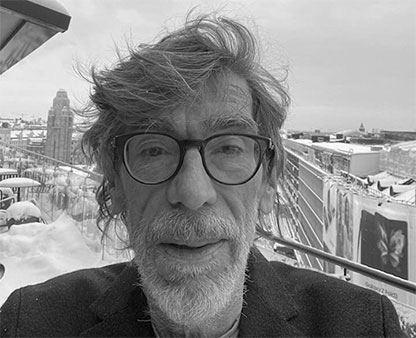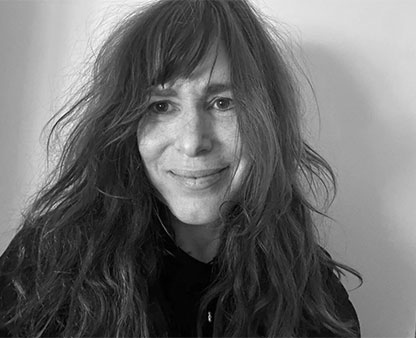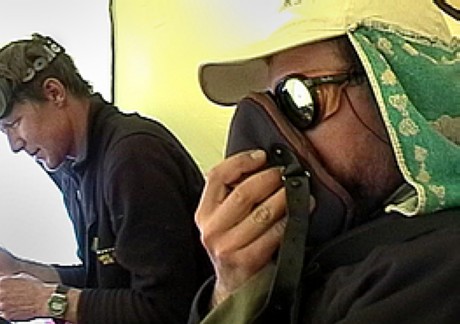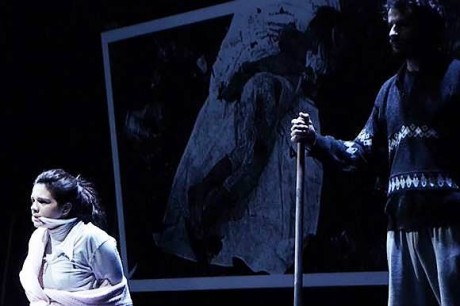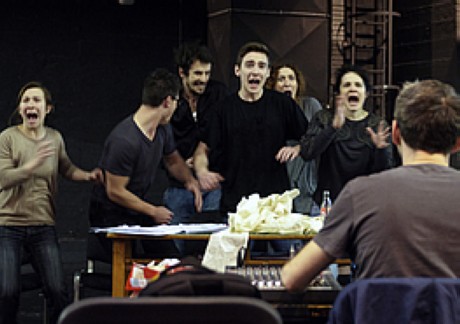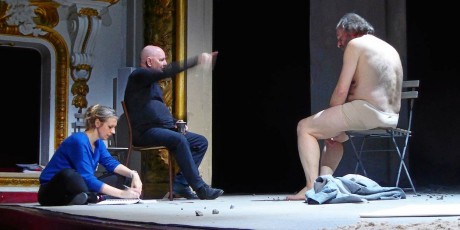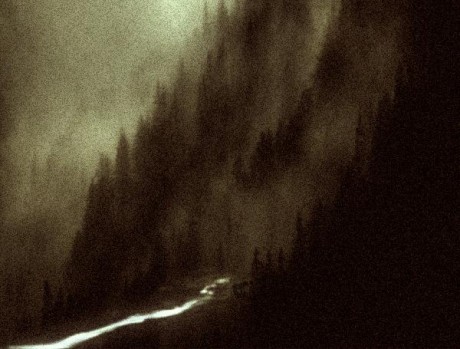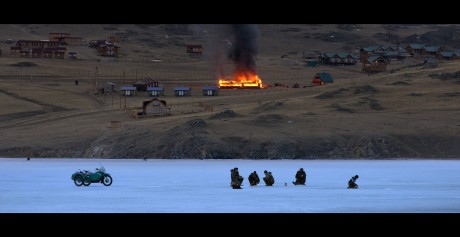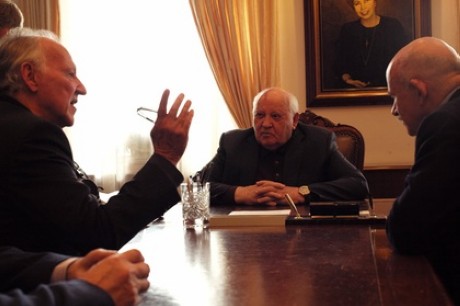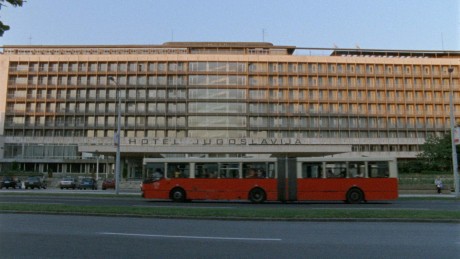MENS DE SKRIVES
1
”… Ligesom Beckett, eller Strindberg, er Lars Norén absolut realistisk. Hvad hans personer og digte siger, er det, der sker i dem nu og her, mens de skrives, mens nogen læser dem eller ser på dem eller lytter til dem. Det er dét, og ikke noget andet. Lars Norén lyver ikke.”
Peter Laugesen skriver i Information den 14. juli et aldeles tankevækkende stykke, en af sine kunsthistorier, tror jeg det må være, fra i vinter, nu bearbejdet og redigeret ind i en serie om svensk film og litteratur med videre, skriver en præsentation af Lars Norén med et godt biografisk resumé og en ligeså overraskende beskrivelse af digterens nye teaterstykke Støv. Jeg standser ved den vidunderlige formulering og læser igen: ”Hvad hans personer og digte siger, er det, der sker i dem nu og her, mens de skrives, mens nogen læser dem eller ser på dem eller lytter til dem. Det er dét, og ikke noget andet.”
Mens de skrives… Jeg gentager den forunderlige formulering og føler mig med den med ét styrket i min måde at opleve på, sådan at min læsning af Torben Skjødt Jensens dokumentarfilm over opførelser af teaterstykker bygger på, at jeg ser dem skrive og skildre alle disse øjeblikke, hvor teatret bliver til i skuespillernes kunst i hvert eneste øjeblik af opførelsen. Og i min genlæsning af Bergmans film, opdagede jeg for nylig, at Bergmans samtlige spillefilm sådan på denne bestemte måde kan ses som en lang række dokumentariske film eller blot én eneste lang og stor dokumentarfilm om en gruppe skuespillere, som arbejder med i filmromanform (filmdrama, spillefilm) at undersøge Bergmans liv og tænkning og erkendelser og dæmoner. Og min læsning af Werner Herzogs film har længe været, at hver eneste scene er en tydeliggørelse på film af hvad, han tænker og skriver netop de sekunder, han optager scenen, og de sekunder, jeg senere ser den i biografen.
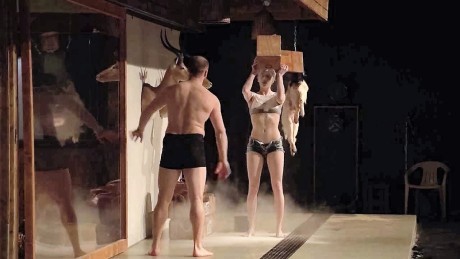


2
Peter Laugesen skriver videre om rollerne, om de medvirkende, om personerne i og om forfatteren til Støv:
”… Måske tier de, måske siger de ingenting, måske har de aldrig sagt noget, måske er der ikke dem, der taler, men nogle andre, måske er det bare en sindssyg forfatter, der finder på det hele, og den sindsyge forfatter kommer klaprende på sin maskine baglæns ud af tiden som en Benjamin’sk historiens engel i en mere og mere støvet genopførelse af af Samuel Becketts Glade Dage.”
Jeg ser det sådan, at som englen hos Norén er Paul Klee’s i maleriet, som Walter Benjamin læser det, er Torben Skjødt Jensens engel skuespilleren og hendes indsigt i sig selv og tilbageskuende i sit eget liv, er Bergmans engel Johan Sebastian Bach, som kommer med sin musik fra mødet med Gud og Guds nære virkelighed. Herzogs budbringer-engel er hans lidenskabelige empati om og lige på sin anden side hans blide kærlighed til den virkelighed, han rammer ind 2:3 lige der på sin al tid vigtige location. Altså disse fire: 1) historiens forfærdede engel 2) himlens skønheds engel 3) menneskelivets erfarne engel og 4) kulturhistoriens moralske engel.
3
Her tilføjer jeg en lille allonge om Klee’s billede. I Wim Wenders: Der Himmel über Berlin, 1987 kommer Bruno Ganz og Otto Sander som disse frakkeklædte engle usynlige ind til de mange læsende (Rilkes scene fra Malte Laurids Brigges Optegnelser) på Staatsbibliothek. De kan, da de er engle, ikke kun høre tanker, men også, hvad der læses, og blandt de mange mumlende stemmer med sætninger om livet i regnskoven, om sommeren, som lakker mod enden, om merværdiafgift, om sammenfatning af ligninger, om kærligheden, om vemod ved soldaterne ved fronten og et bygkorn i øjet (i et Alban Berg brev), om DNA molekylet… skelner jeg:
“Walter Benjamin købte 1921 Paul Klees akvarel ANGELUS NOVUS. Indtil sin flugt fra Paris i juni 1940 hang det i hans vekslende arbejdsværelser. I sit sidste skrift Über den Begriff der Geschichte, 1940, fortolkede han billedet som allegori over tilbageblikket på historien…” Så tager andre stemmer over, men jeg husker Benjamins tekst:
“… Det viser en engel, som ser ud til at bevæge sig væk fra noget, han stirrer på. Hans øjne er vidtåbne, hans mund er åben, hans vinger er foldet ud. Det er sådan historiens engel må se ud. Hans ansigt er vendt mod fortiden. Mens en kæde af begivenheder er hvad vi oplever, ser han én enkelt katastrofe, som stabler tilintetgørelse på tilintetgørelse og slynger dem for hans fødder. Englen ville gerne blive, levende eller død, og gøre helt igen, hvad der er blevet knust. Men en storm blæser fra Paradis, og den har fået fat i hans vinger. Den er så stærk, at englen ikke kan folde dem sammen. Den storm driver ham uimodståelig ind i fremtiden, som han vender ryggen til, mens stablen af murbrokker foran ham vokser mod himlen. Denne storm er hvad vi kalder fremskridt…”
Som Lars Norén i sit kammerspil skildrer Wenders i sin film det, Klees og Benjamins forfærdede engel ser…
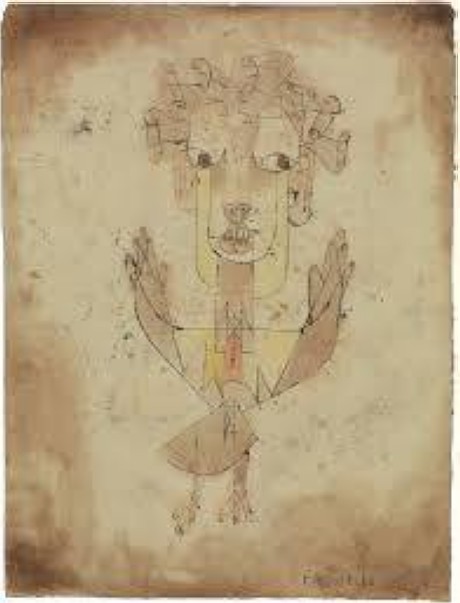
LINK
https://www.information.dk/moti/2018/07/antipsykedeliske-lars-noren (for Informations abonnenter)
LITTERATUR
Peter Laugesen: Kunsthistorier, 1991
Walter Benjamin: Über den Begriff der Geschichte, 1940
FOTOS
Lars Nóren instruerer sit stykke Poussière på Comédie-Française, februar 2018, fotografi.
Torben Skjødt Jensen: Dokumentarfilm over Mikkel Flyvholms opsætning af Eksil, 2013, still.
Ingmar Bergman: Sarabande, 2003, still.
Werner Herzog: Lo and Behold, 2016, still.
Paul Klee: Angelus Novus / Historiens Engel, den akvarel, som Walter Benjamin skriver om.

